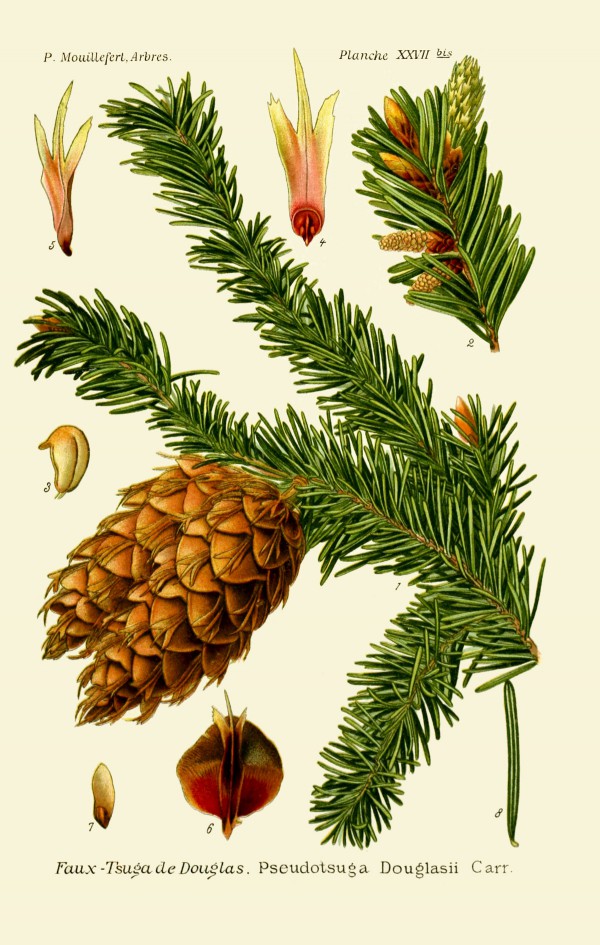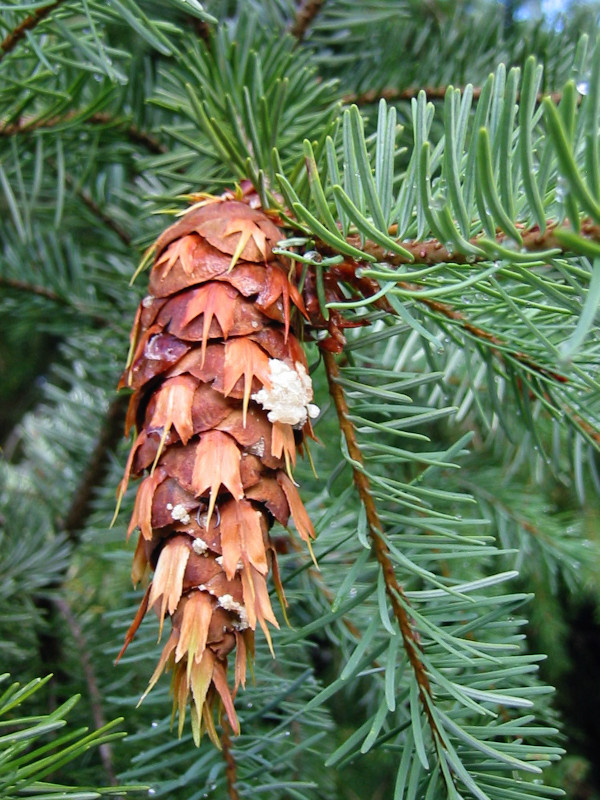Pseudotsuga menziesii (Mirb.) Franco - Pinaceae - Douglas fir, Douglasie
Evergreen tree, up to 67 m tall, native to western North America, cultivated elsewhere (in Europe for Christmas trees e.g.); mature bark dark brown, thick, deeply furrowed; leaves (needles) flat, soft, linear, 2-4cm long, with two whitish bands on the lower surface, completely encircling the branches; deciduous seed cones 5-9cm long; seed wings less than 25mm long.
https://plants.usda.gov/plantguide/pdf/cs_psme.pdf
Pseudotsuga menziesii var. glauca = Rocky Mountain Douglas fir
Pseudotsuga menziesii var. menziesii = coast Douglas fir (Küstendouglasie)
https://npgsweb.ars-grin.gov/gringlobal/taxonomydetail.aspx?30191
https://en.wikipedia.org/wiki/Douglas_fir
The pale yellow oil of the needles owns a sweet, fresh, rich, green-resinous bouquet with a woody-balsamic undertone.
http://www.thegoodscentscompany.com/data/es1096451.html
„Because of wind shakes old trunks of Douglas fir often contains cracks or pockets filled with an oleoresin. This 'pocket resin' is sometimes collected. The yield per tree usually veries from one to as much as 15 gallons.“
Main components of this oeloresin were resin acids (54%) and diterpenes including thunbergene (1.8%), thunbergol (11.3%), isopimarinal (4.8%), and resin acid methyl esters (3.6%). Volatiles included monoterpenoids like α-pinene (6.7%), β-pinene (2.0%), Δ3-carene (0.6%), limonene (6.7%), terpineol (5.6%), and the sesquiterpene isolongifolene (0.2%).
[Erdtman, Holger, et al. „The constituents of the “pocket resin” from Douglas fir Pseudotsuga menziesii (Mirb.) Franco.“ Acta Chem. Scand 22 (1968): 938-942] http://actachemscand.dk/pdf/acta_vol_22_p0938-0942.pdf
Commercial Douglas fir needle oils contained mainly monoterpenes like α-pinene (9.2-15%), β-pinene (17-31%), sabinene (7.2-20%), Δ3-carene (7-13%), and terpinolene (10-15%); monoterpene alcohols and esters like terpinen-4-ol (3.6-6.3%), citronellol (0.5-2.1%), citronellyl acetate (1.6-5.7%), and geranyl acetate (0.5-2.4%). Ester content reaches 3-8%. A prominent citric note is due to the presence of limonene, citronellol, and citronellyl acetate.
[Wolz, Dietmar, and Gerhard Buchbauer. Aromatherapie in Wissenschaft und Praxis. Ed. Wolfgang Steflitsch. Stadelmann, 2013, 507-509]

Pseudotsuga menziesii (Mirb.) Franco as Pseudotsuga douglasii (Sabine ex D. Don) Carrière
Mouillefert, P., Traité des arbres et arbrissaux, Atlas, t. 27bis (1892-1898)
http://botanicalillustrations.org/species.php?id_species=844367

Pseudotsuga menziesii subsp. menziesii - Douglas-fir cone and foliage.
Author: Walter Siegmund (2005) CC BY-SA 3.0Wikimedia Commons